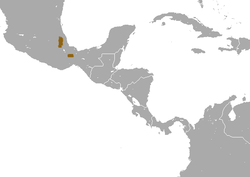Habitat, distribution, and survival
With an estimated range around 6,400 to 12,000 km², S. macrodon is endemic to Mexico and occupies mossy banks, moist cloud forest, and dense oak forests, where it may live under rocks or logs, beside streams, and in weedy vegetation. [1] Mexican large-toothed shrews inhabit pine-oak, coniferous, and tropical forest growing inside the Trans-Mexican Volcanic Belt (TVB) within the southernmost Sierra Nevada. [3] This natural landmark is found inside the Gulf of Mexico, and is a recognized hotspot for diversity, endemicity, and geographic transition of living biology - it boasts more than 75% of the sporadic distribution of S. macrodon. [4] This particular species is entirely terrestrial; coincident species include: Megadontomis cryophilus, Peromyscus aztecus, and Peromyscus furvus. [5] S. macrodon shares extensive trails with Lepus callotis, and Microtus oaxacensis, as well as mountainous territory – at altitudes of 4200 meters - along with fellow shrews S. veraepacis, S. saussurei, and S. trowbridgii. [6] Species are micro endemic to the neotropics of Veracruz, Oaxaca, and Puebla in southern Mexico. [7] Uninhibited destruction of local forests continues to shrink its narrow habitat. In 2005, civilian development had rendered 84% of the shrew's original range unsuitable. "Biological Conservation" records that only 15.95% of S. macrodon habitat remained ecologically intact after deforestation; less than 25% of their potential distributions endured. In farmland, shrews are likely to be affected by pesticides either through secondary contamination by the food chain or by direct exposure. Destruction of habitat boundaries, including markers such as forest limits and grass lines, diminish S. macrodon survival rates within small and sparse distribution. As a result, even small natural disasters or human interferences – such as mining operations, livestock ranching, wood-harvesting, or forest fires – could exterminate the entire population. [8] Unfortunately, the Mexican large-toothed shrew is very poorly known, even in its native country. In summary, agriculture and urbanization pose major extinction threats to Sorex macrodon. [9]
This page is based on this
Wikipedia article Text is available under the
CC BY-SA 4.0 license; additional terms may apply.
Images, videos and audio are available under their respective licenses.

